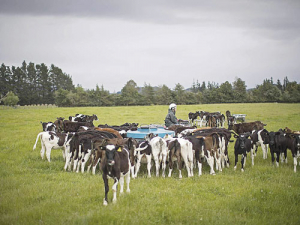In seasonally calving herds all heifers are expected to be fertile and mated at the same time, but their birth dates typically span four-six weeks.
This means that later-born calves need to grow faster than older calves to meet the minimum weight required for puberty so as to be ready for the mating start date (MSD).
To achieve this their weight-for-age targets should be based on their MSD, and they may end up being younger than 15 months at MSD.
An Irish study investigated the relationship between age and body weight at the planned start of mating (PSM) on puberty and lifetime productivity. Although there was a relationship between age and puberty, age didn’t affect lifetime productivity.
Heifers’ body weight at PSM had a far greater influence. The study also indicated that the heifers’ farm of origin had a larger effect than their birth date on lifetime productivity. This indicates that while birth dates have an influence on animal performance, how heifers are managed onfarm can compensate for late calving.
Farmer experience suggests that the range of weights in a heifer mob remains similar, or widens, as heifers age. Lighter animals will not catch up unless they are treated preferentially to increase their growth rate.
The percentage difference in animal weights may remain the same but the difference in weight will become more obvious as animals age. For example, if a mob has an average weight of 100kg, a 10 % difference of 10kg will not be so obvious as a 10% difference in a mob with a 400kg average weight where there will be a 40kg difference. Early intervention is the most effective strategy.
Key points
- Later-born and lighter heifers can struggle to meet liveweight targets. Appropriate management can help to compensate.
- Any of several management strategies can be used to accelerate growth. Early intervention will give the best results.
- Individuals much behind the mob average liveweight need closer scrutiny to identify the cause and initiate prompt action.
Options to boost growth
Increase milk intakes
- Calves more efficiently put on weight by using the energy obtained from milk than from pasture or concentrates. They can use about 86% of the energy in milk to meet their maintenance requirements and 69% for growth. In contrast, they can use about 75% of the energy in a good calf meal to meet their maintenance requirements and 57% for growth.
- The feed required for growth increases with age.
- A 100kg heifer requires 22 MJ ME for 1kg of liveweight gain while a 200kg heifer requires 27 MJ ME. Increasing the rate of gain early is the most efficient strategy.
- Wean later-born animals off milk at a heavier weight.
- Feeding milk for longer, and weaning calves at a heavier weight, gives them the opportunity to use the extra energy they can gain from milk to catch up with older calves. Add an extra 4-5kg to the minimum weaning weight for every extra week later a calf is born so they reach similar weights as the older animals. Feed meal for longer post-weaning and/or increase the protein content of feed.
- Animals will eat more if a feed has a higher crude protein content.
- Young animals have a small rumen. Grass is a bulky feed and fills the rumen quickly. This is an issue when pasture has a very low dry matter or is otherwise of poor quality at weaning. Concentrates are less likely to limit intakes in younger animals because they are less bulky.
Improve feed quality post-weaning
- Delay relocation and keep weaned calves on the milking platform for longer.
- Run younger and lighter animals separately and feed them preferentially.
- Use leader/follower grazing. Allow calves to graze selectively before a less sensitive stock class follows to graze out the paddock.
Preferential management when contract grazing
- Any specialised care for light heifers should be planned and negotiated before stock are relocated. A grazier may not be able to provide preferential care, or wish to supply the extra labour and supplements. If the grazier is willing to manage light animals preferentially then the stock owner’s requirements and expectations, and any extra payment for supplements and the labour associated with feeding out, will need to be discussed.
• Article sourced from DairyNZ


















